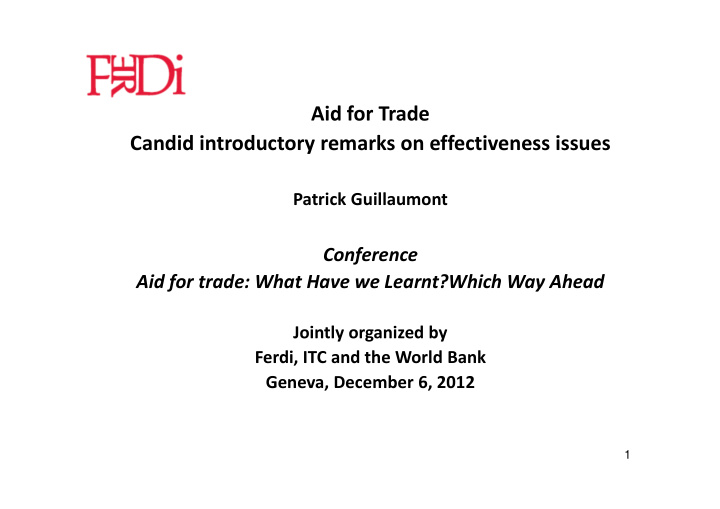



Aid for Trade Candid introductory remarks on effectiveness issues Patrick Guillaumont Conference Aid for trade: What Have we Learnt?Which Way Ahead Jointly organized by Ferdi, ITC and the World Bank Geneva, December 6, 2012 1
How to assess the effectiveness of a flow not identified? • Everything (every part of aid) can be AfT, as it could have been said for aid to reach the MDGs, whatever the ad hoc classifications used for one or the other • Which specificity of the effectiveness of AfT, compared to the effectiveness of overall aid, examined in a separate literature, at least at the macro level? • If it is effectiveness to promote trade, AfT will be all the aid flows effective to promote trade! • Not an a priori concept, but a concept resulting from a relationship • Moreover is AfT is always « aid », i.e. ODA, as it’s said? 2
What’s the criterion of effectiveness? • Effectiveness to promote trade… • But trade is only a means to promote growth and growth a means to reduce poverty and reach the MDGs (trade goals are only intermediary goals) • The issue becomes the effectiveness of aid to promote growth and reduce poverty through trade , a broader perspective than that of the effectiveness of aid for trade, as usually considered • Does it involves to come back to the current literature on aid effectiveness? • Depends on the micro or macro level 3
Is there again a micro-macro paradox? • As often argued about aid effectiveness… • Many impact analyses of what is a priori considered as AfT, with significant results, as presented at this conference • Not really different from the impact analysis of any development assistance project • But quite previous few studies of the macroeconomic impact of Aft (as exceptions, Cali &te Velde,2011; Vijil &Wagner, 2012) • The macro assessment of AfT meets (suffer from) the debates raised by the macroeconomics of (overall) aid effectiveness 4
Back to the aid effectiveness macroeconomics • Besides the two main technical, although crucial issues, the endogeneity of aid and its heterogeneity, which may be even more acute for AfT, there are some substantial issues • Fungibility of AfT (what does AfT really finance?), answer: even if fungible, AfT has an impact through its knowledge content (transfer of best practices?) Additionality of AfT: renaming a part of aid is not adding it to • its total amount, but it can help to moblilize new resources, if the effectiveness of their use as AfT is evidenced 5
Macroeconomics of AfT effectiveness: the competitiveness issue • Main effects of AfT expected from an improvement of the non-price components of competitiveness • But possible negative effects of a huge aid increase on the price competitiveness, through a RER appreciation • An effect however debated, and depending on the time frame and sector targetting of AfT, as for other aid inflows • Effective AfT is first an aid enhancing competitiveness 6
Macroeconomics of aid effectiveness: the vulnerability issue • A major obstacle to trade and growth is risk and vulnerability • Aid can be designed so that it dampens shocks, at the macro as well as micro level, and thus lowers vulnerability • Aid in a majority of cases found to have a stabilizing impact with regard to exports (Chauvet & Guillaumont, 2009) • Not an effect of AfT, but a trade related effect of aid 7
Macroeconomics of AfT at the world level Can the success of AfT be self-defaiting? • Is there a risk of fallacy of composition? Could be the case if AfT promotes export supply of specific goods • with rigid demand in several countries or global export supply in many countries, resulting in a drop of world prices • A point often made during the 80s adjustment, often wrongly, and not valid if the increase in competiveness by AfT is not targetted on specific (and similar) products Little risk of AfT leading to immerizing growth! • • High importance of research, as presented in the today workshop, to show how AfT can be a major tool for poverty reduction 8
9
10
11
12
13
14
Recommend
More recommend